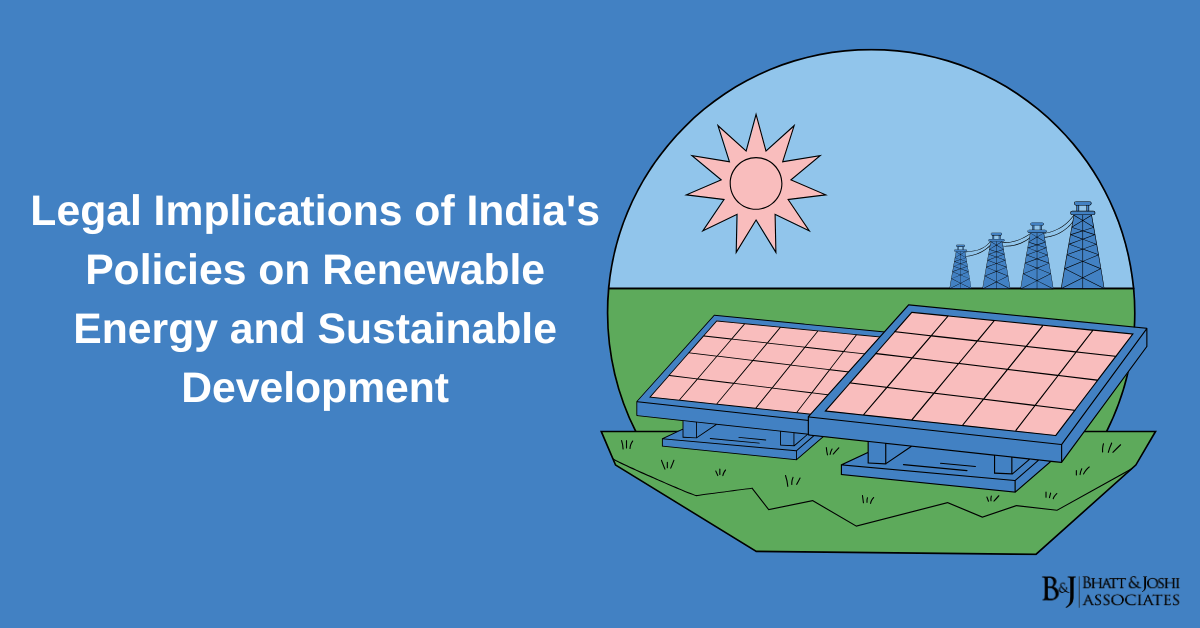Introduction
India, as one of the fastest-growing economies in the world, faces a crucial challenge in addressing its escalating energy demands while minimizing environmental degradation. The dual objectives of meeting energy security and ensuring environmental sustainability are central to India’s developmental strategy. Renewable energy and sustainable development, therefore, occupy pivotal roles in shaping the nation’s policy framework. India’s legal systems, policies, and judicial pronouncements provide the backbone for implementing these objectives. This article explores the multifaceted legal implications of India’s renewable energy policies and sustainable development strategies, examining the regulatory frameworks, laws, landmark judgments, and international commitments that define this domain.
Renewable Energy in India: An Overview
India is endowed with a rich array of renewable energy resources, including solar, wind, hydropower, and biomass. Recognizing this potential, the government has launched several flagship initiatives such as the National Solar Mission, the National Wind-Solar Hybrid Policy, and programs to harness small hydro and biomass energy. These initiatives aim to diversify the energy mix, reduce dependency on fossil fuels, and achieve ambitious climate targets.
The Ministry of New and Renewable Energy (MNRE) spearheads these efforts, providing policy guidance and financial incentives to attract investment in the renewable energy sector. The Electricity Act, 2003, serves as a cornerstone for the development and integration of renewable energy into India’s energy grid. It mandates State Electricity Regulatory Commissions (SERCs) to promote renewable energy generation, facilitate grid connectivity, and set renewable purchase obligations (RPOs). These obligations require electricity distribution companies to procure a specified percentage of their energy from renewable sources, thereby driving demand and investment in this sector.
Regulatory Frameworks Governing Renewable Energy
India’s regulatory framework for renewable energy development is rooted in a combination of national and state-level policies. The Electricity Act, 2003, establishes the overarching legal structure, empowering regulatory bodies to integrate renewable energy into the power sector. The Energy Conservation Act, 2001, complements this by promoting energy efficiency measures, which are critical for reducing overall energy demand and enhancing sustainability.
The National Tariff Policy, revised in 2016, underscores the importance of renewable energy by mandating a minimum percentage of power procurement from renewable sources. This policy incentivizes renewable energy developers by guaranteeing long-term purchase agreements and providing preferential tariffs. The Renewable Energy Certificates (RECs) mechanism, introduced under this framework, allows entities to meet their RPOs by trading certificates instead of directly generating renewable power. These measures collectively aim to create a conducive environment for the renewable energy sector.
Challenges and Legal Implications of Renewable Energy
Despite the progressive legal frameworks, the implementation of renewable energy policies faces several challenges. One of the most significant issues is land acquisition. Large-scale solar and wind farms require substantial tracts of land, often leading to conflicts with local communities and environmental concerns. The Land Acquisition, Rehabilitation, and Resettlement Act, 2013, provides guidelines for fair compensation and resettlement, but disputes over land use and ownership frequently lead to litigation, delaying project implementation.
Environmental clearance processes pose another challenge. While renewable energy projects are generally considered environmentally benign, large-scale projects, especially hydropower installations, can have significant ecological and social impacts. These projects often face delays due to stringent environmental clearance requirements under the Environment Protection Act, 1986, and related regulations. Judicial interventions in such cases highlight the tension between developmental and environmental priorities.
Grid integration is another critical issue. Renewable energy sources like solar and wind are inherently variable and intermittent, posing challenges for grid stability. Regulations under the Central Electricity Authority (CEA) seek to address these issues by mandating infrastructure upgrades and advanced forecasting systems. However, the financial and technical burden of these measures often falls on state utilities, which are already grappling with fiscal constraints.
Contractual disputes also have significant legal implications. Power Purchase Agreements (PPAs) between renewable energy developers and distribution companies frequently lead to litigation over issues such as tariff renegotiations and delayed payments. These disputes underscore the need for clear and enforceable contractual terms to protect the interests of all stakeholders.
Case Laws on Renewable Energy and Sustainable Development
The Indian judiciary has played a proactive role in shaping the legal landscape for renewable energy and sustainable development. Landmark judgments have clarified legal ambiguities, enforced compliance with regulatory frameworks, and balanced competing interests.
The case of M.C. Mehta v. Union of India (1987), though primarily focused on environmental protection, laid the groundwork for judicial intervention in matters of public interest, including renewable energy development. This case established the principle that environmental conservation is integral to sustainable development, influencing subsequent judicial decisions.
In Adani Power Ltd. v. Central Electricity Regulatory Commission (2018), the Supreme Court addressed disputes related to PPAs in renewable energy projects. The judgment emphasized the importance of adhering to contractual obligations and highlighted the role of regulatory commissions in resolving such disputes. Similarly, Energy Watchdog v. Central Electricity Regulatory Commission (2017) underscored the need for transparent and fair regulatory practices in determining tariffs for renewable energy projects.
Sustainable Development: Policies and Legal Frameworks
Sustainable development is enshrined in India’s Constitution and serves as a guiding principle for its legal and policy frameworks. Article 48A mandates the state to protect and improve the environment, while Article 51A(g) imposes a duty on citizens to safeguard natural resources. These constitutional provisions underpin India’s legislative and policy efforts to achieve sustainable development.
The Environment Protection Act, 1986, provides a comprehensive legal framework for environmental protection, empowering the central government to regulate activities that impact the environment. This Act forms the basis for renewable energy projects requiring environmental clearances. The Forest Conservation Act, 1980, regulates the diversion of forest land for non-forest purposes, balancing developmental needs with ecological conservation.
India’s National Action Plan on Climate Change (NAPCC) is a key policy instrument for achieving sustainable development. It comprises eight national missions, including the National Solar Mission and the National Mission on Enhanced Energy Efficiency, which directly contribute to the expansion of renewable energy. State-level action plans align with the NAPCC, ensuring coherence in policy implementation.
The National Green Tribunal (NGT) Act, 2010, established a specialized tribunal to handle environmental disputes. The NGT has played a crucial role in expediting the resolution of cases related to renewable energy projects and sustainable development, thereby reducing delays and uncertainties.
Judicial Pronouncements Supporting Sustainable Development
The Indian judiciary has consistently upheld the principles of sustainable development. The landmark case of Vellore Citizens’ Welfare Forum v. Union of India (1996) introduced the precautionary principle and the polluter pays principle into Indian jurisprudence. This judgment has had far-reaching implications for renewable energy projects, ensuring that environmental risks are minimized.
In T.N. Godavarman Thirumulpad v. Union of India (1997), the Supreme Court emphasized the importance of forest conservation. This judgment has influenced the approval process for renewable energy projects requiring forest land, striking a balance between development and ecological preservation. Similarly, the Essar Oil Ltd. v. Halar Utkarsh Samiti (2004) case highlighted the need to harmonize industrial development with environmental sustainability.
The case of Delhi Development Authority v. Aditya Holistic Approach Pvt. Ltd. (2017) stressed the integration of sustainability principles into urban planning. This judgment is particularly relevant for the deployment of renewable energy technologies in urban areas, such as rooftop solar installations and energy-efficient buildings.
International Commitments and Their Legal Implications
India’s international commitments significantly influence its renewable energy and sustainable development policies. The Paris Agreement under the United Nations Framework Convention on Climate Change (UNFCCC) represents a landmark global effort to combat climate change. India’s Nationally Determined Contributions (NDCs) under this agreement include a target of achieving 40% of installed electricity capacity from non-fossil fuel sources by 2030. This commitment has driven ambitious renewable energy targets and policy reforms.
The Kigali Amendment to the Montreal Protocol, which aims to phase out hydrofluorocarbons (HFCs), aligns with India’s renewable energy goals by promoting energy-efficient technologies. Similarly, the Sustainable Development Goals (SDGs) adopted by the United Nations provide a comprehensive framework for integrating renewable energy into broader developmental objectives. Goal 7, which focuses on affordable and clean energy, directly aligns with India’s renewable energy initiatives.
Future Directions and Recommendation
To achieve its renewable energy and sustainable development goals, India must address the challenges hindering policy implementation. Strengthening the legal and regulatory frameworks is essential to ensure clarity, consistency, and enforceability. Enhancing public-private partnerships can attract investment and foster innovation in renewable energy technologies. Simplifying land acquisition and environmental clearance processes while ensuring transparency and stakeholder engagement can reduce delays and conflicts.
The judiciary’s proactive role in interpreting laws and resolving disputes must be complemented by capacity building in regulatory institutions. Investing in grid infrastructure and adopting advanced forecasting and storage technologies are critical for integrating renewable energy into the grid. Additionally, fostering international collaboration and leveraging financial and technological support under global agreements can accelerate India’s transition to a sustainable energy future.
Conclusion
India’s policies on renewable energy and sustainable development reflect a strong commitment to addressing climate change and achieving energy security. While significant progress has been made, challenges related to land acquisition, regulatory enforcement, and grid integration persist. The legal and judicial frameworks have been instrumental in advancing these objectives, but further reforms and innovations are needed to overcome existing barriers.
By aligning domestic policies with international commitments and fostering collaboration among stakeholders, India can lead the global transition to a sustainable energy future. Strengthening the synergy between renewable energy initiatives and sustainable development goals will ensure that the nation’s growth trajectory remains environmentally and socially inclusive.













